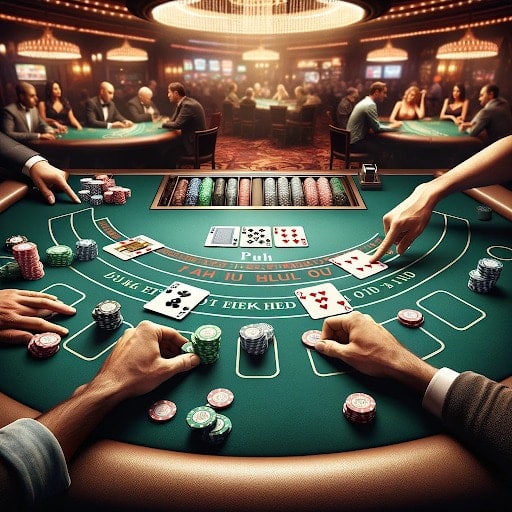- Crypto Casinos
- Bitcoin Games
- Reviews
- Learn
- Essentials
- Are Bitcoin Casinos Legal?
- Crypto Wallets for Gambling
- VPN for Bitcoin Casinos
- What is RTP?
- Gambler’s Fallacy
- Deposit with Credit Card On Bitcoin Casino
- Bankroll Management
- How To Play Bingo
- What Casino Game Has the Best Odds
- Best Casino Game To Win Money
- How VIP Programs Work
- RNG in Casinos
- Slot Machine Odds
- How Free Spins Work
- Poker Cheat Sheet
- Guides
- How to Play Texas Holdem Poker
- How to Play Three Card Poker
- How to Play Pai Gow Poker
- How To Play Omaha Poker
- How to Play Caribbean Stud Poker
- How to Play Seven Card Stud
- How to Play Mississippi Stud Poker
- Poker Odds Guide
- Card Counting in Blackjack
- What is a Blackjack Split
- What is a Push in Blackjack
- Roulette Wheel Explained
- How to Play Craps
- Craps Odds Explained
- Craps Come Bet
- How to Play Baccarat
- Moneyline Betting Explained
- Arbitrage Betting Explained
- How Sportsbetting Betting Odds Work
- Video Poker Odds
- Limit vs No Limit Poker
What is a Push in Blackjack: Understanding the Tie Game
Pushes are a common occurrence in blackjack, but many players may not fully understand what they are or how they work.
In simple terms, a push occurs when the player and the dealer have the same total hand value. When this happens, the player doesn’t win or lose any money, and the bet is returned to them.
Pushes are a unique aspect of blackjack that sets it apart from other casino games and different crypto casinos. They can be frustrating for players who are hoping to win big, but they also offer a level of security and fairness.
Understanding how pushes work is essential for players who want to make the most of their blackjack experience, as it can impact their betting strategy and overall gameplay.
In the following sections, we’ll dive deeper into what pushes are and how they affect the game of blackjack.
Basics of Blackjack
Blackjack, also known as 21, is a popular card game found in casinos worldwide. The basic goal of blackjack is simple: to beat the dealer’s hand without going over 21.
The Objective of Blackjack
Blackjack, also known as 21, is a popular card game played in crypto casinos around the world. The objective of the game is to beat the dealer by having a hand that is worth more points than the dealer’s hand, without going over 21 points.
Each card is worth its face value, with face cards (Jack, Queen, King) worth 10 points, and Aces worth either 1 or 11 points, depending on the player’s choice.
Players begin by placing their bets, and then the dealer deals two cards to each player and two cards to themselves. One of the dealer’s cards is face up, and the other is face down.
Players can then choose to “hit” (receive another card) or “stand” (keep their current hand). The dealer must hit until their hand is worth at least 17 points.
Understanding the Push
In the game of blackjack, a “push” occurs when the player and the dealer have the same hand value. In this case, the player neither wins nor loses their bet, and the game is considered a tie.
For example, if a player has a hand worth 18 points and the dealer also has a hand worth 18 points, it is a push. The player does not lose their bet, but they also do not win any money.
It is important to note that in some variations of blackjack, such as Spanish 21, a push may not result in a tie and may instead result in a win for the dealer.
Players need to understand the rules of the specific variation of blackjack they are playing to avoid confusion and potential losses.
Rules of a Push in Blackjack
In blackjack, a “push” is a rule that comes into play when the total value of the player’s hand equals the total value of the dealer’s hand. Here are the key rules and implications of a push in blackjack:
Dealer-Player Tie
In blackjack, a push occurs when the player and the dealer have the same total hand value. This is also known as a tie. When a push occurs, the player neither wins nor loses their bet. Instead, the player’s bet is returned to them.
If the player has a hand value of 21 and the dealer also has a hand value of 21, this is also considered a push. However, if the player has a hand value of 21 and the dealer has a hand value of 20, the player wins the hand.
Bet Handling in a Push
When a push occurs, the dealer will collect all losing bets and return all winning bets to the respective players.
The dealer will then return the bets of the players who tied with the dealer. The chips of the tied players will remain on the table and they can choose to leave them there for the next hand or take them back.
It is important to note that in some casinos, a push may not result in the player getting their bet back. In these cases, the player loses their bet in the event of a push.
It is always important to check the rules of a particular crypto blackjack casino or table before playing.
In conclusion, a push in blackjack occurs when the player and the dealer have the same hand value.
In the event of a push, the player neither wins nor loses their bet, but instead, their bet is returned to them. Players need to be aware of the rules regarding pushes in the casino they are playing at to avoid any confusion or misunderstandings.
Strategies Involving a Push
In the context of blackjack, developing strategies around the possibility of a push—a situation where the player and dealer have hands of equal value, resulting in neither a win nor a loss—can be a key aspect of effective gameplay.
Risk Management
When a player and the dealer have the same total in blackjack, it is called a push. While it may seem like a neutral outcome, it is a valuable opportunity for players to manage their risk.
One strategy is to use the push to minimize losses by betting smaller amounts. This way, if the player loses, they will not be losing as much as they would have if they had bet a larger amount.
Another strategy is to use the push to take advantage of the dealer’s tendencies. If the dealer is consistently pushing, it may indicate that they are not hitting their desired cards. In this case, the player can adjust their strategy to take advantage of this weakness and potentially win more hands.
Betting Strategies
Betting strategies involving the push are also popular among blackjack players. One such strategy is the “up and pull” method, where the player increases their bet after a win and decreases it after a loss.
If the player pushes, they keep their bet the same. This strategy can help players capitalize on winning streaks while minimizing losses during losing streaks.
Another betting strategy is the “Oscar’s Grind” method, where the player increases their bet after a win and keeps it the same after a loss.
If the player pushes, they also keep their bet the same. This method is designed to help players slowly and steadily increase their profits while minimizing losses.
Overall, the push in blackjack is not a neutral outcome but rather an opportunity for players to manage their risk and potentially increase their winnings through strategic betting.
Push Probabilities
Understanding push probabilities is crucial for players, as it affects game strategy and risk assessment. It’s an essential aspect of blackjack that impacts the overall house edge and player decisions, influencing how a player might approach each hand and manage their bets.
Statistical Occurrence
In blackjack, a push occurs when the player and the dealer have the same total value of cards in their hands. This is a fairly common occurrence in the game and happens more frequently than a win or a loss.
According to statistics, the probability of a push in a single-deck game is around 8.5%, while in a six-deck game, it increases to about 9.5%.
Players should be aware that the likelihood of a push varies depending on the number of decks used in the game. The more decks in play, the higher the probability of a push. Therefore, it is important to consider the number of decks when deciding on a blackjack strategy.
Impact on House Edge
Pushes have a significant impact on the house edge in blackjack. Since a push results in neither a win nor a loss for the player, it effectively reduces the number of hands played, which in turn reduces the total amount of money wagered. As a result, the house edge is slightly increased when a push occurs.
For example, in a single-deck game where the dealer stands on soft 17, the house edge is approximately 0.44%.
However, if the game results in a push, the house edge increases to 0.55%. In a six-deck game, the house edge increases from 0.46% to 0.54% when a push occurs.
Players should keep in mind that while pushes may seem like a neutral outcome, they do have an impact on the overall profitability of the game.
It is important to understand the probabilities and the impact on the house edge when making decisions in blackjack.
Common Questions
Push vs. Blackjack
One of the most common questions asked by players is the difference between a push and a blackjack. In blackjack, a push occurs when the player and the dealer have the same total hand value.
When this happens, the player neither wins nor loses the hand, and their original bet is returned.
On the other hand, a blackjack is when the player’s initial hand is an ace and a ten-value card, totaling 21. This hand is unbeatable, and the player is paid out at a rate of 3:2.
Push in Variant Games
Pushes can occur in many different blackjack variants, including Spanish 21, Pontoon, and Super Fun 21. In these games, the rules may differ slightly from traditional blackjack, but the concept of a push remains the same.
For example, in Spanish 21, a player’s 21 always beats the dealer’s 21, but a push still occurs if both the player and dealer have a hand value of 21. In Pontoon, a push occurs if both the player and dealer have a hand value of 21 or if both have a five-card trick.
Conclusion
In conclusion, understanding the concept of a push is essential in blackjack, as it can affect the outcome of a hand and the player’s overall strategy. It is important to note that the rules may differ slightly in variant games, but the basic concept remains the same.
Jack is a junior content writer for Bitcoin Casinos since March 2023. He has previously published local sports stories for the Shildon Town Crier, where he is based and studied Journalism. Jack's main hobby is football, being a massive fan of Newcastle United.
Recent Posts
-
Cryptocurrency Miners Stockpile Near-Record Amount Of Bitcoin Ahead Of Friday’s Supply Cut
-
Snoop Dogg And Roobet Join Forces To Create ‘Snoop’s High Rollers’ Slot Game
-
Adin Ross ‘Announces’ Surprise Retirement From Streaming At Age 23
-
Ethereum Revealed As The Leading Crypto For Blockchain Hacks In 2024
-
Softswiss Acquires Huge Stake In Europe’s Popular Social Casino SpinArena
1026/02/231006/09/239.705/01/239.704/03/249.405/01/239.205/01/239.107/03/24908/09/23904/03/248.924/01/238.510/10/238.427/03/248.408/09/238.227/02/24








